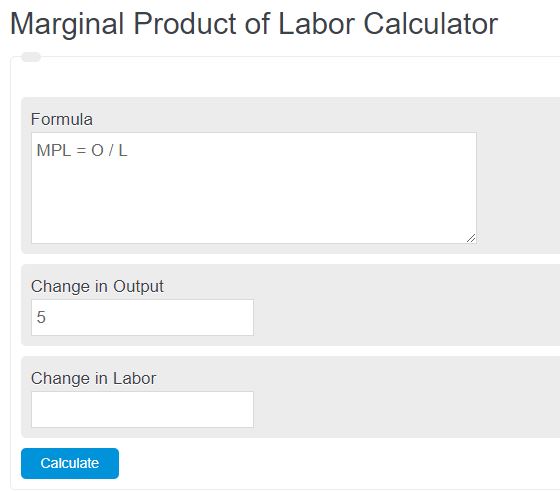Enter the total change in output and change in labor. The calculator will evaluate and display the marginal product of labor.
- MPC Calculator
- Marginal Cost Calculator
- Marginal Utility Calculator
- Marginal Rate of Substitution Calculator
- Marginal Revenue Product (MRP) Calculator
Marginal Product of Labor Formula
The following equation is used to calculate the marginal product of labor.
MPL = O / L
- Where MPL is the marginal product of labor
- O is the change in output
- L is the change in labor
To calculate the marginal product of labor, divide the change in output by the change in labor.
Marginal Product of Labor Definition
The marginal product of labor is a ratio of the change in output that occurs with a change in labor. It measures how much output changes with changing labor forces. In ideal situations, an increase in labor would yield an increase in output. This will yield a ratio greater than 1.
Marginal Product of Labor Example
How to calculate a marginal product of labor?
- First, determine the change in output.
Measure the change in output over a certain time period.
- Next, determine the change in input.
Measure the change in input over the same time period.
- Finally, calculate the marginal product of labor.
Using the formula, calculate the marginal product of labor.
FAQ
What factors can affect the marginal product of labor?
Several factors can affect the marginal product of labor, including the quality of the labor force, the technology used in production, the amount of capital available, and the efficiency of the production process. Changes in any of these factors can lead to variations in the marginal product of labor.
How does the law of diminishing returns relate to the marginal product of labor?
The law of diminishing returns states that as more units of a variable input (like labor) are added to fixed amounts of other inputs, the additional output produced by the additional input will eventually decrease. This means that after a certain point, adding more labor will result in smaller increases in output, reflecting a decrease in the marginal product of labor.
Can the marginal product of labor be negative?
Yes, the marginal product of labor can be negative. This occurs when the addition of more labor leads to a decrease in total output. This could be due to factors such as overcrowding, where too many workers cause inefficiencies, or a mismatch between the skills of the labor force and the tasks they are assigned to.
Why is the marginal product of labor important for businesses?
Understanding the marginal product of labor is crucial for businesses as it helps them determine the most efficient level of labor employment. By knowing how changes in labor affect output, businesses can optimize their labor costs, improve productivity, and make informed decisions about hiring, training, and investment in technology.
